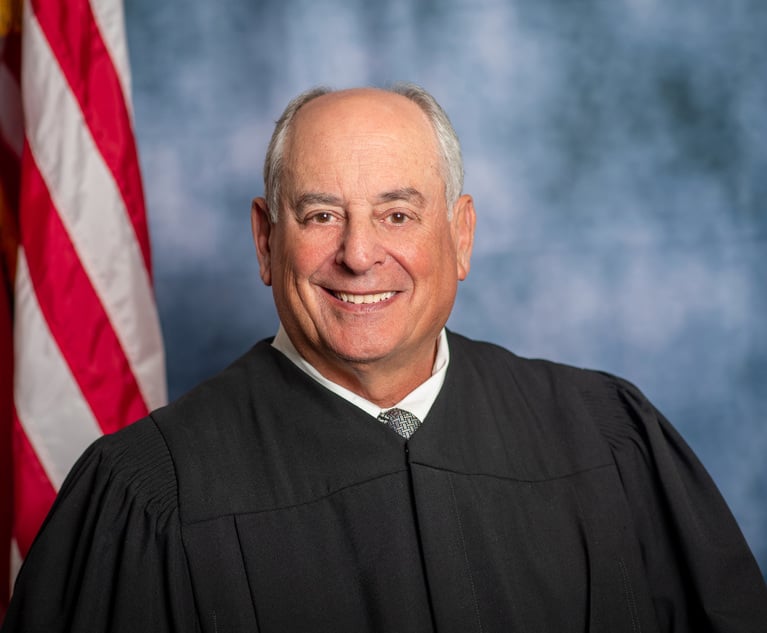 Randall Kessler (Photo: John Disney/ALM)
Randall Kessler (Photo: John Disney/ALM)Trial by Zoom: We Have Begun a New Era
Making objections was much easier and more dignified. The students raised "Objection Paddles" to the screen. Much more polite than yelling "objection!" I imagine there will soon be a litigation package for Zoom where you press "O" for the word "OBJECTION" to flash upon the screen.
April 27, 2020 at 11:46 AM
5 minute read
On Friday, April 17, perhaps the first Trial by Zoom was held in Georgia. It was the final exam for the Emory Law School Jury Trial class. The fact pattern for the students was a divorce.
Typically the final exam is held in a real courtroom with real judges, but this time Fulton County Superior Court judges presided over virtual courtrooms, via Zoom. Chief Judge Chris Brasher and Judges Rebecca Crumrine Rieder, Jane Barwick and Paige Reese Whitaker, participated along with Emory Law adjunct professors Rob Wellon, Jim Holmes, Senior Judge Gail Tusan and me (professor Amy Kaye had a conflict). The law school offered invaluable technical support.
While it was only a law school class, it was treated as authentic a trial as possible. The judges were real, the facts were from a real case, and the lawyers took it very seriously. And what a learning process it was. Not just for the students, but for us the teachers and the judges. We all learned that not only could trial by Zoom work, but there were quite a few unanticipated benefits. Many will help convince lawyers, judges and litigants that trial by Zoom should become a permanent option, even when courthouses fully reopen.
Here are a few of those benefits we recognized during and after the trials:
Making objections was much easier and more dignified. The students raised "Objection Paddles" to the screen. Much more polite than yelling "objection!" I imagine there will soon be a litigation package for Zoom where you press "O" for the word "OBJECTION" to flash upon the screen.
The lawyers (and judges) could see themselves and because of this, everyone became more self-aware. Typical facial gestures like eye-rolling and generally looking inattentive or bored simply did not occur.
The rule of sequestration was so much easier. It was done by keeping witnesses in the virtual wait room. No one had to go out in the hall and call for them when it was their turn. We simply pushed a button.
And if the judge needed a break, like to confer with me (the bailiff) or check the status of another matter, we simply sent everyone to the wait room. It was a much shorter break than waiting for everyone to walk out or the judge having to go back to chambers.
And then there are the benefits that may seem trivial, but on a grand scale can save thousands of dollars and hours. Everyone arrived on time. There were no delays because of traffic, parking or car trouble. There were no delays at security, no confusion about which courtroom was being used and no struggles bringing boxes up to the courtroom (all things which typically happen every time we go to court).
We saved trees. Exhibits were pre-loaded and simply shared on screen as needed (so no need to make copies for everyone).
And for a real trial, clients will not be embarrassed by seeing people they know in the halls, and lawyers won't abandon their clients to catch up with colleagues they run into. The trial starts, progresses and concludes and everyone is home the minute it is done. And think of the fees saved by clients who won't have to pay for their lawyer to travel to and from court!
Yes there were some negatives. Not everyone had a nice set up or background for their camera. But some used virtual backgrounds, and for sure the ease and quality of the background imaging will improve over time.
While it may not be for every litigant or judge, and while the logistics of a jury trial by Zoom will take some work, the extraordinary convenience, simplicity and personal safety of Zoom trials is now obvious to me. And aren't there times when we, or our clients (or even judges) would truly rather not be in the same room as the other side?
Certainly some cases will always be better served by in-person hearings. Cases where the demeanor of witnesses, tough custody cases and other situations where there may simply be no substitute for a live, in-person hearing will always exist. But for cases where judges, clients and lawyers all want to be efficient, to be reached at the time for which their case was scheduled (or if delayed, to at least not be stuck in a courthouse, but rather at work or home where they can get more accomplished), and to not have to spend three hours of a day getting to and from court for a 30-minute hearing, and for those who have no real desire to be in the physical presence of their opponent (every divorce client), trial by Zoom, or Skype, or FaceTime, or Google Hangouts or Duo must be a consideration. It just makes too much sense. We may have been forced to evolve, but Trial by Zoom looks like it is here to stay, so let's make the best of it. And it's really not that hard.
Randy Kessler founded Kessler & Solomiany. He has chaired the family law sections of the American Bar Association, the State Bar of Georgia and the Atlanta Bar Association.
This content has been archived. It is available through our partners, LexisNexis® and Bloomberg Law.
To view this content, please continue to their sites.
Not a Lexis Subscriber?
Subscribe Now
Not a Bloomberg Law Subscriber?
Subscribe Now
NOT FOR REPRINT
© 2025 ALM Global, LLC, All Rights Reserved. Request academic re-use from www.copyright.com. All other uses, submit a request to [email protected]. For more information visit Asset & Logo Licensing.
You Might Like
View All
North Carolina Courts Switch to Digital, Face Extreme Weather in 2024

'A 58-Year-Old Engine That Needs an Overhaul': Judge Wants Traffic Law Amended
3 minute read
Fulton Jury Returns Defense Verdict After Pedestrian Killed by MARTA Bus
8 minute read
'The Best Strategy': $795K Resolution Reached in Federal COVID-Accommodation Dispute
8 minute readLaw Firms Mentioned
Trending Stories
Who Got The Work
Michael G. Bongiorno, Andrew Scott Dulberg and Elizabeth E. Driscoll from Wilmer Cutler Pickering Hale and Dorr have stepped in to represent Symbotic Inc., an A.I.-enabled technology platform that focuses on increasing supply chain efficiency, and other defendants in a pending shareholder derivative lawsuit. The case, filed Oct. 2 in Massachusetts District Court by the Brown Law Firm on behalf of Stephen Austen, accuses certain officers and directors of misleading investors in regard to Symbotic's potential for margin growth by failing to disclose that the company was not equipped to timely deploy its systems or manage expenses through project delays. The case, assigned to U.S. District Judge Nathaniel M. Gorton, is 1:24-cv-12522, Austen v. Cohen et al.
Who Got The Work
Edmund Polubinski and Marie Killmond of Davis Polk & Wardwell have entered appearances for data platform software development company MongoDB and other defendants in a pending shareholder derivative lawsuit. The action, filed Oct. 7 in New York Southern District Court by the Brown Law Firm, accuses the company's directors and/or officers of falsely expressing confidence in the company’s restructuring of its sales incentive plan and downplaying the severity of decreases in its upfront commitments. The case is 1:24-cv-07594, Roy v. Ittycheria et al.
Who Got The Work
Amy O. Bruchs and Kurt F. Ellison of Michael Best & Friedrich have entered appearances for Epic Systems Corp. in a pending employment discrimination lawsuit. The suit was filed Sept. 7 in Wisconsin Western District Court by Levine Eisberner LLC and Siri & Glimstad on behalf of a project manager who claims that he was wrongfully terminated after applying for a religious exemption to the defendant's COVID-19 vaccine mandate. The case, assigned to U.S. Magistrate Judge Anita Marie Boor, is 3:24-cv-00630, Secker, Nathan v. Epic Systems Corporation.
Who Got The Work
David X. Sullivan, Thomas J. Finn and Gregory A. Hall from McCarter & English have entered appearances for Sunrun Installation Services in a pending civil rights lawsuit. The complaint was filed Sept. 4 in Connecticut District Court by attorney Robert M. Berke on behalf of former employee George Edward Steins, who was arrested and charged with employing an unregistered home improvement salesperson. The complaint alleges that had Sunrun informed the Connecticut Department of Consumer Protection that the plaintiff's employment had ended in 2017 and that he no longer held Sunrun's home improvement contractor license, he would not have been hit with charges, which were dismissed in May 2024. The case, assigned to U.S. District Judge Jeffrey A. Meyer, is 3:24-cv-01423, Steins v. Sunrun, Inc. et al.
Who Got The Work
Greenberg Traurig shareholder Joshua L. Raskin has entered an appearance for boohoo.com UK Ltd. in a pending patent infringement lawsuit. The suit, filed Sept. 3 in Texas Eastern District Court by Rozier Hardt McDonough on behalf of Alto Dynamics, asserts five patents related to an online shopping platform. The case, assigned to U.S. District Judge Rodney Gilstrap, is 2:24-cv-00719, Alto Dynamics, LLC v. boohoo.com UK Limited.
Featured Firms
Law Offices of Gary Martin Hays & Associates, P.C.
(470) 294-1674
Law Offices of Mark E. Salomone
(857) 444-6468
Smith & Hassler
(713) 739-1250






